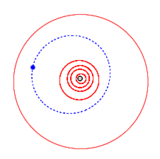1000 Piazzia
|
Orbital comparison: 1000 Piazzia (blue) vs. the inner planets (red) and Jupiter (outermost) | |||||||||||||||||
| Discovery [1] | |||||||||||||||||
|---|---|---|---|---|---|---|---|---|---|---|---|---|---|---|---|---|---|
| Discovered by | K. Reinmuth | ||||||||||||||||
| Discovery site | Heidelberg Obs. | ||||||||||||||||
| Discovery date | 12 August 1923 | ||||||||||||||||
| Designations | |||||||||||||||||
| MPC designation | 1000 Piazzia | ||||||||||||||||
Named after |
Giuseppe Piazzi (astronomer)[2] | ||||||||||||||||
|
1923 NZ · 1951 OB 1967 ED | |||||||||||||||||
| main-belt · (outer) [3] | |||||||||||||||||
| Orbital characteristics [1] | |||||||||||||||||
| Epoch 27 June 2015 (JD 2457200.5) | |||||||||||||||||
| Uncertainty parameter 0 | |||||||||||||||||
| Observation arc | 92.35 yr (33,730 days) | ||||||||||||||||
| Aphelion | 3.9889 AU | ||||||||||||||||
| Perihelion | 2.3563 AU | ||||||||||||||||
| 3.1726 AU | |||||||||||||||||
| Eccentricity | 0.2572 | ||||||||||||||||
| 5.65 yr (2,064 days) | |||||||||||||||||
Average orbital speed | 16.45 km/s | ||||||||||||||||
| 103.55° | |||||||||||||||||
| Inclination | 20.570° | ||||||||||||||||
| 323.76° | |||||||||||||||||
| 280.84° | |||||||||||||||||
| Physical characteristics | |||||||||||||||||
| Dimensions |
47.78±2.0 km (IRAS:17)[4] 51.55±0.86 km[5] 49.54±6.12 km[6] 47.15 km (derived)[3] | ||||||||||||||||
| Mass | 1.1×1017 kg | ||||||||||||||||
Mean density | 2.0 g/cm³ | ||||||||||||||||
Equatorial surface gravity | 0.0133 m/s² | ||||||||||||||||
Equatorial escape velocity | 0.0252 km/s | ||||||||||||||||
|
9.47±0.01 h[7] 9.2±0.2 h[8] | |||||||||||||||||
|
0.1119±0.010 (IRAS:17)[4] 0.097±0.004[5] 0.041±0.029[6] 0.0457 (derived)[3] | |||||||||||||||||
| |||||||||||||||||
| S [3] | |||||||||||||||||
| 10.6[1] | |||||||||||||||||
|
| |||||||||||||||||
1000 Piazzia, provisional designation 1923 NZ, is a dark asteroid from the outer region of the asteroid belt, about 48 kilometers in diameter. It was discovered by German astronomer Karl Reinmuth at Heidelberg Observatory in southern Germany, on 12 August 1923.[10]
The asteroid orbits the Sun at a distance of 2.4–4.0 AU once every 5 years and 8 months (2,064 days). Its orbit shows an eccentricity of 0.26 and is tilted by 21 degrees to the plane of the ecliptic.[1]
After the asteroid had been published by The Minor Planet Bulletin as an opportunity for photometry in 2001, an analysis of a classically double shaped minimum–maximum light-curve performed at Santana Observatory (646) in Rancho Cucamonga, California, showed it to have a rotation period of 9.47±0.01 hours with a brightness amplitude of 0.45.[7] According to the surveys carried out by Infrared Astronomical Satellite, IRAS, the Japanese Akari satellite, and the NEOWISE mission of the U.S.Wide-field Infrared Survey Explorer, the asteroid's surface has an albedo in the range of 0.04 to 0.11.[4][5][6] Although the Collaborative Asteroid Lightcurve Link (CALL) derives a low albedo in accordance to the space-based surveys, CALL classifies the body as a S-type rather than a carbonaceous C-type asteroid.[3]
The minor planet was named in honour of Italian Giuseppe Piazzi (1746–1826), Theatine monk and director of the observatories of Palermo and Naples, who elaborated a catalog of 7,646 stars. In 1801, Piazzi discovered 1 Ceres, the first and largest asteroid and the main-belt's only dwarf planet. He is also honoured by the lunar crater Piazzi.[2]
References
- 1 2 3 4 "JPL Small-Body Database Browser: 1000 Piazzia (1923 NZ)" (2015-12-18 last obs.). Jet Propulsion Laboratory. Retrieved January 2016.
- 1 2 Schmadel, Lutz D. (2003). Dictionary of Minor Planet Names – (1000) Piazzia. Springer Berlin Heidelberg. p. 86. ISBN 978-3-540-29925-7. Retrieved January 2016.
- 1 2 3 4 5 "LCDB Data for (1000) Piazzia". Asteroid Lightcurve Database (LCDB). Retrieved January 2016.
- 1 2 3 Tedesco, E. F.; Noah, P. V.; Noah, M.; Price, S. D. (October 2004). "IRAS Minor Planet Survey V6.0". NASA Planetary Data System. Bibcode:2004PDSS...12.....T. Retrieved January 2016.
- 1 2 3 Usui, Fumihiko; Kuroda, Daisuke; Müller, Thomas G.; Hasegawa, Sunao; Ishiguro, Masateru; Ootsubo, Takafumi; et al. (October 2011). "Asteroid Catalog Using Akari: AKARI/IRC Mid-Infrared Asteroid Survey". Publications of the Astronomical Society of Japan 63 (5): 1117–1138. Bibcode:2011PASJ...63.1117U. doi:10.1093/pasj/63.5.1117. Retrieved January 2016.
- 1 2 3 Masiero, Joseph R.; Mainzer, A. K.; Grav, T.; Bauer, J. M.; Cutri, R. M.; Nugent, C.; et al. (November 2012). "Preliminary Analysis of WISE/NEOWISE 3-Band Cryogenic and Post-cryogenic Observations of Main Belt Asteroids". The Astrophysical Journal Letters 759 (1): 5. arXiv:1209.5794. Bibcode:2012ApJ...759L...8M. doi:10.1088/2041-8205/759/1/L8. Retrieved January 2016.
- 1 2 Stephens, R. D. (September 2001). "Rotational Periods and Lightcurves of 1096 Reunerta and 1000 Piazzia". Bulletin of the Minor Planets (Section of the Association of Lunar and Planetary Observers) 28: 56. Bibcode:2001MPBu...28...56S. Retrieved January 2016.
- ↑ Behrend, Raoul. "Asteroids and comets rotation curves – (1000) Piazzia". Geneva Observatory. Retrieved January 2016.
- ↑ "Planetary Habitability Calculators". Planetary Habitability Laboratory. University of Puerto Rico at Arecibo. Retrieved 22 December 2015.
- ↑ "1000 Piazzia (1923 NZ)". Minor Planet Center. Retrieved January 2016.
External links
- Asteroid Observing Services
- Asteroid Lightcurve Database (LCDB), query form (info)
- Dictionary of Minor Planet Names, Google books
- Asteroids and comets rotation curves, CdR – Observatoire de Genève, Raoul Behrend
- Discovery Circumstances: Numbered Minor Planets (1)-(5000) – Minor Planet Center
- 1000 Piazzia at the JPL Small-Body Database
| ||||||
| ||||||||||||||||||||||||||||
